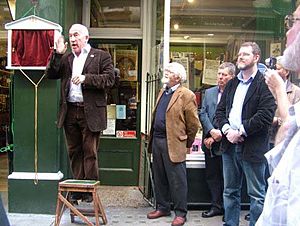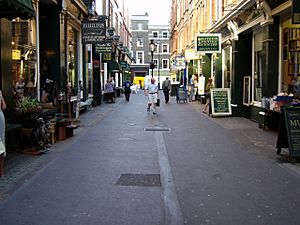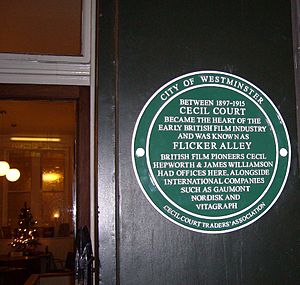Cecil Court facts for kids
Cecil Court is a special pedestrian street in Westminster, England. It has many old-fashioned shops from the Victorian era. This street connects Charing Cross Road and St Martin's Lane. Since the 1930s, it has been known as a famous place for booksellers.
Contents
A Historic Street with Unique Shops
Cecil Court is one of the oldest streets in Covent Garden. It has been around since the late 1600s. Long ago, it was a simple path for traders. Later, it was nicknamed "Flicker Alley" because many early film companies were located there.
Today, Cecil Court is home to about a dozen independent bookshops. These shops sell all sorts of interesting books, like rare first editions, collectible children's books, and old maps. You can also find art galleries, antique shops, and stores selling old silver, coins, jewelry, and porcelain.
The street is sometimes called "Booksellers' Row." There was an older "Booksellers' Row" on Holywell Street, London, but it was taken down around 1900. Cecil Court might be named after Robert Cecil, 1st Earl of Salisbury, who was an important person in Queen Elizabeth I's court. Other nearby places, like Cranbourn Street and The Salisbury pub, are also named after his family.
When Mozart Lived Here

Cecil Court was once a temporary home for a very famous person: an eight-year-old Wolfgang Amadeus Mozart. This was in 1764, when he was on a big tour of Europe with his family. For nearly four months, the Mozart family stayed with a barber named John Couzin.
Tickets for Mozart's first concerts in London were sold from Couzin's shop. While living here, young Mozart played music twice for King George III. A famous musician named Dr. Charles Burney even tested his musical skills. Some experts believe Mozart wrote his very first symphony while living on Cecil Court!
In 2011, a special plaque was put up on Number 9 Cecil Court. This plaque remembers Mozart's time on the street. It was unveiled by actor and author Simon Callow. Music from Mozart's "London Sketchbook" was played at the ceremony. It's possible some of these pieces were composed right there on Cecil Court.
The Birthplace of British Cinema: Flicker Alley
Cecil Court played a huge part in the early days of British cinema. It was nicknamed "Flicker Alley" because so many early film companies were based there. The first film-related business arrived in 1897. This was just a year after the first moving pictures were shown in the UK!
During the Edwardian era, Cecil Court was known as the best place to buy or rent films in London. Many important filmmakers and distributors had offices there. British film pioneers like Cecil Hepworth and James Williamson worked here. International companies like Gaumont and American Vitagraph also had offices on the street.
Cecil Court was important because it was the first place in the UK where film businesses gathered. They shared ideas, products, and even the costs of transporting film reels. At first, many businesses did everything: making films, selling them, and renting equipment. Later, they became more specialized. Some focused only on importing foreign films, or just renting equipment. There was even a business that sold candy for cinemas! For a while, a film magazine called The Bioscope was published from number 8.
A film distribution company in the US, founded in 2002, is named Flicker Alley as a tribute to Cecil Court's history. In 2012, actor Simon Callow returned to Cecil Court to unveil another plaque. This one celebrates "Flicker Alley" and the street's big role in the British film industry.
Cecil Court Today
The Cecil family still owns the street. The buildings you see today were built around 1894. This was when Robert Gascoyne-Cecil, 3rd Marquess of Salisbury, a long-serving British Prime Minister, was in charge.
Today, Cecil Court is part of the Jubilee Walkway, a special walking route opened in 1977. The closest Underground station is Leicester Square.
More Interesting Facts About Cecil Court
- In 1776, Abraham Raimbach, a famous engraver, was born in Cecil Court.
- The magazine The Dome, which focused on art and literature, was published at number 7 from 1897 to 1900.
- Watkins Books, London's oldest bookshop specializing in spiritual and mystical topics, has been at 21 Cecil Court since 1901.
- William and Gilbert Foyle, who founded the world-famous Foyles bookshop, opened their first shop at 16 Cecil Court in 1904. They later moved to their current location on Charing Cross Road.
- In the 1930s, Cecil Court became a meeting place for Jewish refugees. This inspired artist R.B. Kitaj to paint Cecil Court W.C.2. (The Refugees) in the 1980s.
- In 1946, Griffs Bookshop, which sold Welsh books, was opened at 4 Cecil Court by William Griffiths and his brothers.
- In 1983, the British telephone directory company Yellow Pages filmed part of its famous "Fly Fishing" advertisement in Cecil Court.
- In 2006, Cecil Court was used as a filming location for the movie Miss Potter, starring Renée Zellweger.
- In 2010, the Flicker Alley Festival was held in Cecil Court. It celebrated the street's history in early British cinema. They even screened the first Alice in Wonderland film with live music!
- Cecil Court appeared in an episode of The Apprentice in December 2010.
Images for kids







